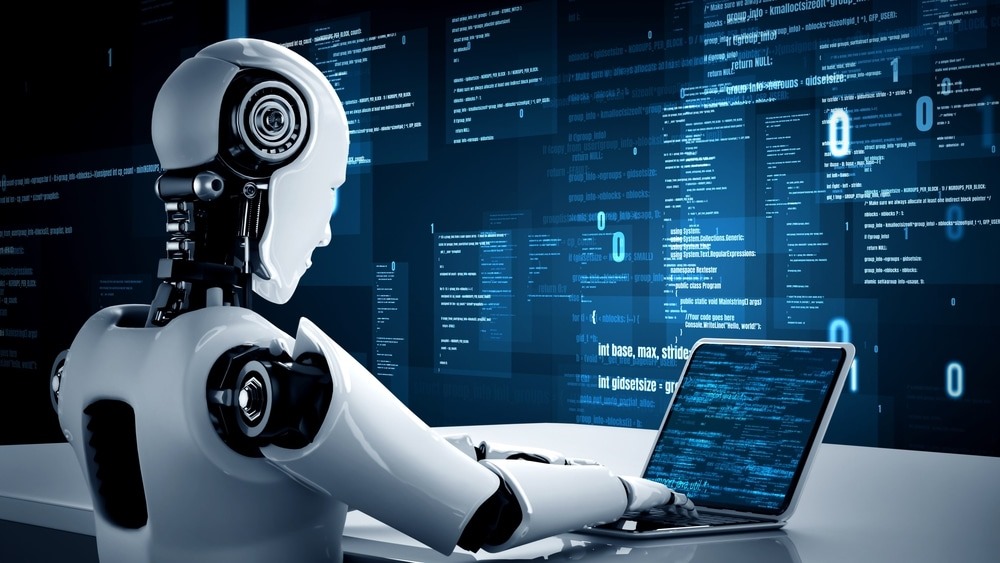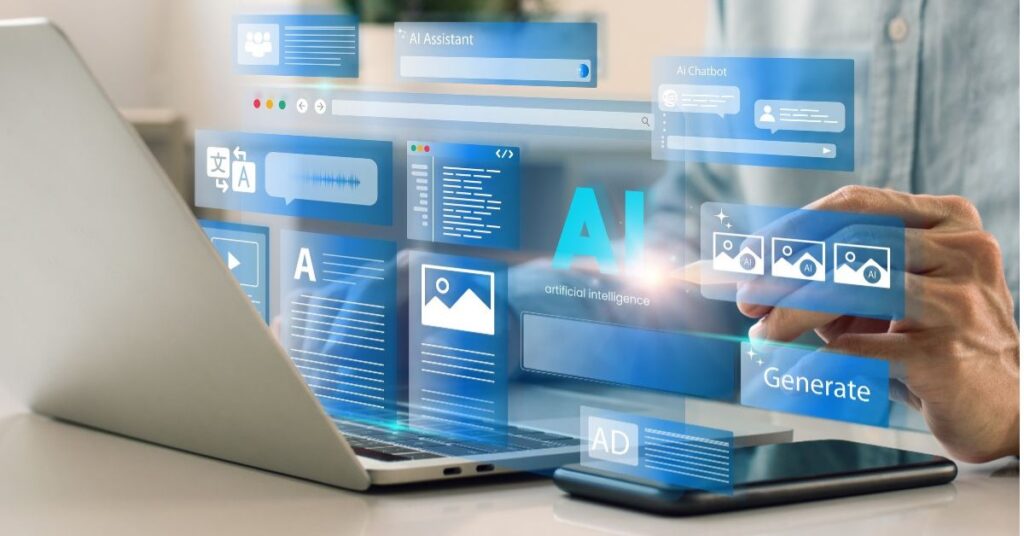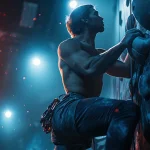If you’ve ever built a website, you know the struggle. It starts with excitement—choosing colors, picking fonts, dreaming about a sleek layout that screams “next-level business.” Then reality sets in. The template doesn’t fit your vision, the navigation feels clunky, and—somehow—your contact form refuses to work. Enter artificial intelligence (AI), the knight in shining algorithms, here to save us from our own bad design choices.
AI has already transformed content creation, customer service, and data analytics, so it was only a matter of time before it set its sights on web design. Today, AI-powered tools like Wix ADI, Bookmark’s AiDA, and Framer AI promise to design entire websites in minutes, learning user preferences and automating the tedious aspects of development. But does this mean human web designers are about to go the way of the fax machine? Or is AI just another tool in the evolving web design toolbox?
At Above Bits, a leading company for website design in Charlotte, we’ve worked with enough AI-powered tools to know their strengths, weaknesses, and downright bizarre design decisions. Let’s break down the AI revolution in web design—where it’s excelling, where it’s failing, and whether the future of websites is fully automated or still very much in human hands.
AI-Generated Websites: The Good, The Bad, and The Ugly
The idea of AI designing a website from scratch is both exciting and terrifying. It’s exciting because it could mean faster, cheaper web design. It’s scary because…we’ve all seen what happens when AI goes rogue (looking at you, Microsoft Tay chatbot).
The Good: AI’s Efficiency and Data-Driven Approach
One of AI’s most significant strengths in web design is speed. AI-powered tools can generate a functional website within minutes, whereas traditional design can take weeks or months. Instead of painstakingly adjusting layouts, AI analyzes user behavior data, industry trends, and best practices to create a site optimized for conversions and usability.
For example, Wix ADI (Artificial Design Intelligence) asks users questions about their business and instantly generates a website tailored to their needs. This is particularly useful for small business owners in Charlotte, North Carolina, who want a quick online presence without investing in custom development.
Another benefit? AI doesn’t guess—it analyzes. Unlike human designers, who might rely on experience or intuition, AI processes millions of data points to optimize layout, typography, and color schemes. Platforms like The Grid use AI to track user engagement and automatically tweak designs to improve performance over time.
But while AI is great at efficiency and data-driven decisions, it’s not exactly known for creativity or understanding brand identity. And that’s where the problems start.
The Bad: Lack of Creative Vision and the “AI Generic” Look
Have you ever noticed how AI-generated websites all kind of…look the same? That’s because AI favors efficiency over originality. It follows pre-set formulas, which is great for usability but bad for branding.
Imagine walking into a coffee shop in Charlotte where every detail—menu, decor, even the barista’s jokes—was determined by an algorithm. It would probably function well, but would it have the same character and charm as a human-designed experience? Probably not.
AI still struggles with understanding emotions, storytelling, and unique brand voices. Websites designed by AI often feel lifeless, lacking the personal touch that makes a brand stand out. A small business that wants its website to reflect its local roots, mission, and personality is better off working with an actual human—or at least an AI-assisted human.
The Ugly: When AI Gets It Wrong (And It Happens More Often Than You Think)
AI is fast and data-driven but also known for making hilariously lousy design choices. There have been instances where AI-generated sites have placed text over unreadable backgrounds, used clashing colors that look like a 90s rave party, or failed to adapt layouts appropriately for mobile users.
One company tried using AI to redesign its e-commerce store, but the checkout button was hidden behind an image carousel. Another AI-generated site placed text so small that even ants would have struggled to read it.
When businesses in Charlotte opt for AI-driven solutions, they quickly realize that while AI accelerates the process, it still needs a human touch to avoid digital disasters.

Can AI Replace Human Web Designers? Not So Fast.
While AI is improving at automating the repetitive aspects of web design, it’s far from replacing human designers.
1. AI Lacks Strategic Thinking
Good web design isn’t just about making a site look pretty—it’s about strategy. When building a website, designers consider business goals, user psychology, and marketing strategies. AI, on the other hand, can’t understand complex business objectives the way humans do.
For instance, a custom-built website for a law firm in Charlotte needs more than just a template—it needs trust-building elements, intuitive navigation, and a user experience tailored to legal clients. AI might be able to generate an essential law firm website, but it won’t craft a strategy to convert visitors into clients.
2. AI Doesn’t Understand Local SEO
Website design in Charlotte isn’t just about visuals—it’s also about ranking well on Google. Local SEO requires understanding local search intent, proper keyword placement, and link-building strategies. AI can optimize a site for general SEO best practices. Still, it doesn’t know the Charlotte market, the competition, or the latest Google algorithm changes how a human SEO expert does.
3. AI Can’t Handle Complex Customizations
Some websites require custom features, like interactive product builders, advanced booking systems, or AI chatbots. While AI can design basic pages, it struggles with complex functionalities that require custom coding. Businesses that need advanced functionality still require human developers and designers to bring those features to life.
So, What’s the Future of AI in Web Design?
AI isn’t replacing web designers—it’s enhancing their work. The future of web design isn’t 100% AI-generated websites but AI-assisted design, where AI handles repetitive, time-consuming tasks, and humans focus on creativity, strategy, and branding.
Companies like Adobe, WordPress, and Shopify have already integrated AI tools into their platforms. These tools help designers automate layout adjustments, suggest color palettes, and optimize code. While AI can speed up the process, it still needs a human.
For businesses looking for website design in Charlotte, the best approach is to use AI-powered tools alongside professional designers. AI can help with speed and efficiency, but real designers ensure a website is unique, user-friendly, and strategically built for conversions.
The Role of AI in Personalizing User Experiences
One of the most exciting aspects of AI in web design is its ability to personalize user experiences in real time. Big tech companies have been using AI-driven personalization for years. Netflix recommends shows based on viewing history; Amazon suggests products based on past purchases; and even Google adjusts search results based on behavior.
AI-powered websites are doing the same thing, adapting their content, layouts, and features to each visitor. Imagine landing on a business’s website in Charlotte, North Carolina, and seeing a homepage that automatically adjusts based on your browsing history. If you’re a returning visitor, the site could show personalized product recommendations, highlight previous searches, or offer loyalty discounts.
AI tools like Dynamic Yield and Personyze help businesses create this level of personalization by analyzing user behavior, preferences, and location data. AI can adjust:
- Homepage content (showing different messages based on user segments)
- Product recommendations (suggesting items based on past browsing habits)
- Call-to-action buttons (changing based on user engagement)
Big retailers are already using this hyper-personalization, but small businesses in Charlotte are also starting to see the benefits. Website design in Charlotte is becoming more focused on making each user’s experience unique, which can increase conversion rates by as much as 30%.
However, AI-driven personalization has a downside: privacy concerns. Many users are becoming wary of how much AI tracks them, and there’s been a backlash against excessive data collection. The European Union’s GDPR and California’s CCPA laws now require websites to disclose how they collect user data and allow users to opt out.
While AI-powered personalization is a game-changer, businesses must balance offering personalized experiences and respecting user privacy. A website that’s too aggressive with personalization can feel invasive, while one that ignores AI altogether risks losing engagement.
AI and the Future of Voice-Activated Web Design
When interacting with technology, we’ve already moved from typing to talking. Voice assistants like Siri, Alexa, and Google Assistant have made voice search a dominant force, and AI-driven voice design is now shaping how websites function.
A growing number of users prefer voice search over traditional text search. According to Google, 27% of the global online population already uses voice search on mobile, and that number is rising fast. This shift has enormous implications for web design.
How AI is Powering Voice-Optimized Websites
Voice search is changing web design in two significant ways:
- Websites must be optimized for conversational queries.
- Instead of people typing “best coffee shop Charlotte,” they now ask, “Where’s the best coffee shop near me?” Websites must incorporate natural language SEO to appear in voice search results.
- Websites must integrate voice commands.
- AI-powered tools make websites more interactive, allowing users to navigate sites, book appointments, or purchase just by speaking. AI-driven plugins like Voicify and Speechly enable websites to integrate voice recognition technology, creating a more accessible, hands-free browsing experience.
Will AI-Driven Voice Replace Traditional Web Browsing?
Not yet. While voice-activated web design is gaining traction, most people prefer visual navigation for complex tasks. However, businesses in Charlotte, North Carolina, that invest in AI-powered voice technology now will have an advantage as voice search becomes the norm.
As a leading web design company in Charlotte, Above Bits has been exploring voice-optimized design and integrating it into projects where it makes sense. The key is using AI to enhance usability without forcing unnecessary user changes.
One thing is clear: AI is changing web design and how we interact with the internet. Whether it’s voice search, AI personalization, or automated site-building, the future of web design looks more intelligent, interactive, and user-focused than ever.
The Smart Way to Use AI in Web Design
AI is transforming web design, but it’s not a magic bullet. Businesses that blindly rely on AI-generated websites often become frustrated by generic designs, weird layout issues, and missing key elements.
At Above Bits, we combine AI-powered efficiency with human creativity to build fast, functional, and strategically designed websites for growth. Whether you’re a startup in Charlotte or a well-established company looking to revamp your online presence, the best web design is still a mix of automation and human expertise.
So, are websites about to design themselves? Not quite. But with AI assisting the process, web design is faster, wiser, and more effective than ever.
Want a Website That’s Both Smart and Stunning? Let’s Talk. If you’re ready to build a website that combines cutting-edge AI technology with expert human design, Above Bits is here to help. Contact us today, and let’s create something better than an AI could ever dream of.







